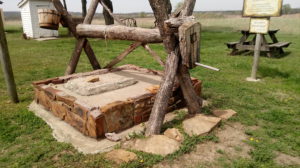It’s a long drive to Independence, Kansas, across the gently rolling farm fields of wheat and corn. But really, what’s a few hours in an air-conditioned car, tires purring along the highway, radio playing? It would take a whole lot longer to make the journey in a covered wagon.
Laura Ingalls Wilder, as everyone knows, crossed the prairie in a covered wagon. She was three years old (not six as in the book) and her memories were simple. “Kansas was an endless flat land covered with tall grass blowing in the wind. Day after day they travelled in Kansas and saw nothing but the rippling grass and the enormous sky. In a perfect circle the sky curved down to the level land, and the wagon was in the circle’s exact middle.”
There’s almost nothing left of the site of what is arguably the most famous Little House in the world. There’s a very nice replica of the house, and a few other historic buildings have been moved to the spot. And a gift shop, of course; Laura Ingalls Wilder stuff is an industry in itself, sunbonnets, mugs, T-shirts, etc. But not a splinter remains of the original log cabin, the stable, the outhouse (never mentioned in prim Laura’s books), nor is there any trace of the garden or Pa’s plowed fields. The only thing left is a hole in the ground.
“Pa marked a large circle in the grass near the corner of the house. WIth his spade he cut the sod insde the circle, and lifted it up in large pieces. Then he began to shovel out the earth, digging himslf deeper and deeper down. Mary and Laura must not go near the well while Pa was digging. Even when they couldn’t see his head any more, shovelfuls of earth came flying up.” In Chapter 12 Laura describes how Pa hand-dug a well many feet deep, down to the cold, clear water below. Finding the hole in the ground is how researchers were able to fix the location of the original house.
The prairie was a tough place to live. The endless wind, the utter lack of shade, the flat horizon—you can see how the brutal monotony drove some pioneers to insanity, as Laura recounted in her later, more somber books. But in her earliest childhood memories, there is no boredom or depression. She was thrilled with the beauty of the prairie, rich with wildflowers, birds, and butterflies.
Laura Ingalls Wilder is somewhat controversial these days. Her books tend to avoid the unpleasant fact that the land Ma and Pa settled on was looted from its original inhabitants, and that every little house she loved was built on stolen ground. But Laura wrote with passion and respect about the people who had lived on the prairie long before she got there. Her account of the Osage Indians passing her cabin, leaving their land for exile in a new territory, is deeply moving. Laura, who was three or four at the time, cried bitter tears as the long procession went by, not fully understanding why she wept.
Nor did she understand the devastation farmers were wreaking on the prairie ecosystem. Her description of Pa busting the sod, with a thin plume of dust drifting from the tip of his plow, makes me shudder. The catastrophe of the Dust Bowl was completely unforeseen as Pa merrily sowed the wheat. “Now we’ll live like kings!” he said, not imagining the grasshoppers, the hail, the fires, the blizzards, and the droughts to come.
But I think Laura Ingalls Wilder is still well worth reading. She is unusual in that she lived the book she wrote. Most historical fiction is written by authors who weren’t there, and even the most diligent researcher can’t possibly understand what it was like to live in another century. Of course, many pioneer women wrote their memoirs, but they tend to be dry and inaccessible, especially for children.
Laura didn’t start writing the Little House books till she was in her 60s, long after the wilderness she remembered had disappeared. She realized that she had to explain how things were back then, in a way kids could understand. She was remembering the sounds and tastes and smells, the toys and scoldings and bedtime stories of half a century ago, all those little details that are usually forgotten. Laura was writing something different than memoir: her books are fiction (she made a lot up, for sure) but they’re made vividly real by her own lived experiences.





WOW just what I was searching for. Came here by
searching for laura ingalls wilder
welcome!